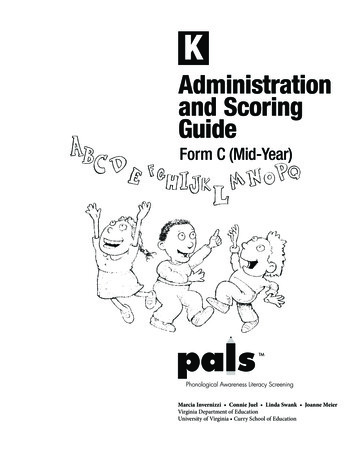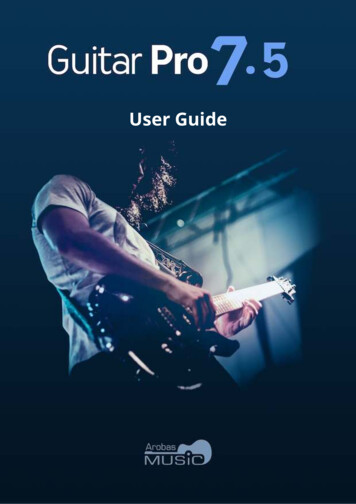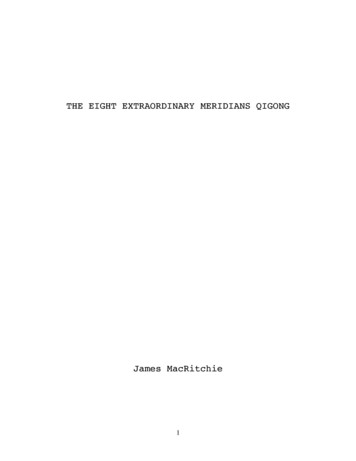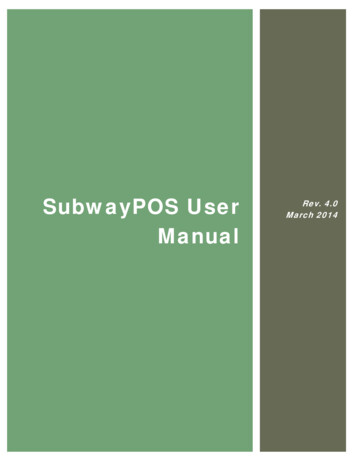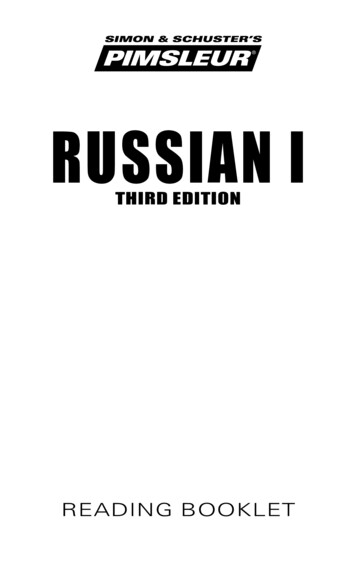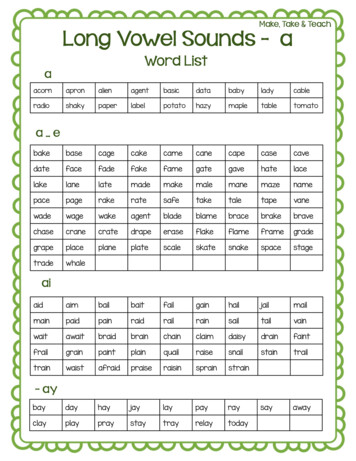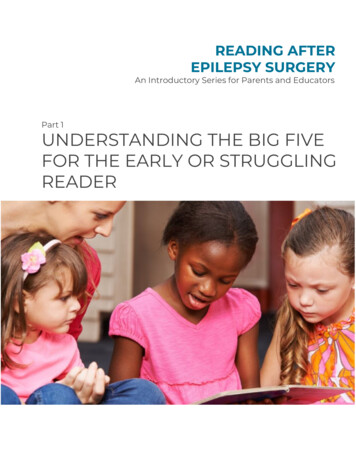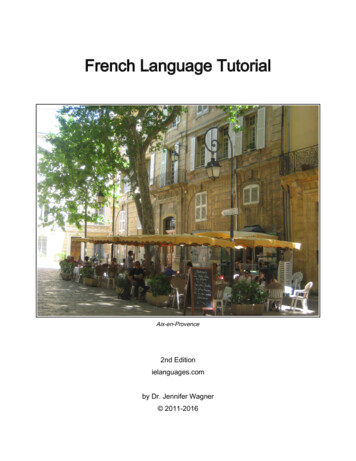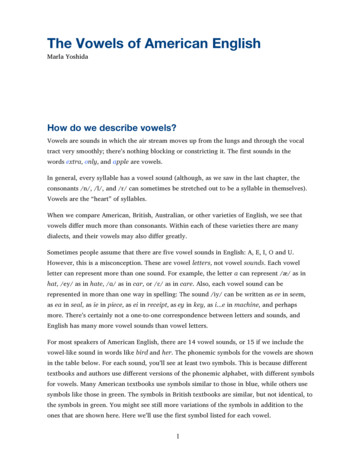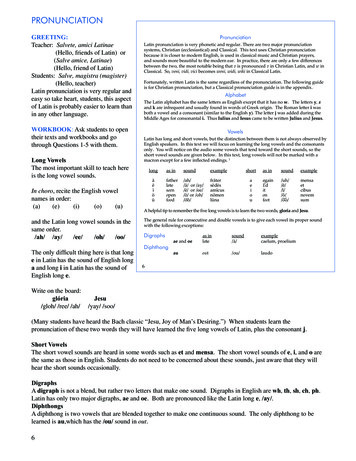
Transcription
U S E RM A N U A L1.0.2
EASTWEST GHOSTWRITERIMPORTANT COMPATIBILITY NOTE!Our Revolutionary New Opus Software EngineOur brand new Opus software engine has been years in development, and replacesthe Play engine. All EastWest Libraries (with the exception of the original HollywoodOrchestra, the original Hollywood Solo Instruments, and the MIDI Guitar Series) aresupported in Opus, allowing them to take advantage of a faster, more powerful, moreflexible, and better looking software engine.Opus comes with some incredible new features such as individual instrument downloads, customized key-switches, new effects for the mixer page, scalable retina userinterface upgrades for legacy products, a powerful new script language, and many morefeatures that allow you to completely customize the sound of each instrument.It’s one of the most exciting developments in the history of our company and will be thelaunching pad for many exciting new products in the future.Using Opus and Play TogetherOpus and Play are two separate software products, anything you have saved in yourprojects will still load up inside the saved Play version of the plugins. You can updateyour current/existing projects to Opus if you so choose, or leave them saved within Play.After purchasing or upgrading to Opus you do not need to use Play, but it may be moreconvenient to make small adjustments to an older composition in your DAW loading theinstruments saved in Play instead of replacing them with Opus. For any new composition, just use Opus.A Note About User ManualsAll EastWest Libraries have their own user manuals (like this one) that refer to instruments and controls that are specific to their respective libraries, as well as referencingthe Play User Manual for controls that are common to all EastWest Libraries.For EastWest Libraries supported for use within Opus, we highly recommend takingadvantage of all the powerful new features it has to offer.Reference this user manual for details related to the instruments and controls specificto this library and, in place of the previously mentioned Play Software Manual, refer tothe Opus Software Manual from the link below instead.OPUS SOFTWARE MANUAL: tware-Manual.pdfii
EASTWEST GHOSTWRITERThe information in this document is subject to change without notice and does not represent a commitment on the part of East West Sounds, Inc. The software and soundsdescribed in this document are subject to License Agreements and may not be copiedto other media. No part of this publication may be copied, reproduced or otherwisetransmitted or recorded, for any purpose, without prior written permission by East WestSounds, Inc. All product and company names are or trademarks of their respectiveowners.Solid State Logic (SSL) Channel Strip, Transient Shaper, and Stereo Compressor licensedfrom Solid State Logic. SSL and Solid State Logic are registered trademarks of Red Lion49 Ltd. East West Sounds, Inc., 2014. All rights reserved.East West Sounds, Inc.6000 Sunset Blvd.Hollywood, CA 90028USA1-323-957-6969 voice1-323-957-6966 faxFor questions about licensing of products: licensing@eastwestsounds.comFor more general information about products: .comiii
EASTWEST GHOSTWRITER1. Welcome235788About EastWestProducer: Steven WilsonProducer: Doug RogersCreditsHow to Use This and the Other ManualsOnline Documentation and Other Resources1
EASTWEST GHOSTWRITERWelcomeAbout EastWestEastWest (soundsonline.com) is the #1 producer and distributor of virtual (software) instruments in the world. With clientele that span the Who’s Who of music, film, television,games, multimedia and performing arts, EastWest has led the industry for more than 25years and provides professionals with the very best music creation tools available.Virtual instruments enable composers and others involved in music production to usemusic keyboards linked to computers to create music that is virtually indistinguishablefrom a live performance to the average person, at a fraction of the cost. A high percentage of the music produced for all media today is produced on computers using EastWest/Quantum Leap virtual instruments.EastWest/Quantum Leap virtual instruments are considered to be the best available, andare endorsed by the Who’s Who of the music, film, TV, and games industries, includingDanny Elfman (Spiderman, Nightmare Before Christmas, Terminator 4); J.J. Abrams(producer Star Trek, Lost); Rene Dupere (Cirque Du Soleil, KA, Mystere); James Newton Howard (The Dark Knight, King Kong); John Powell (Hancock, The Bourne Trilogy);Thomas Newman (Revolutionary Road, WALL-E, Lemony Snickets); Jeff Beal (Rome, Appaloosa, He Was a Quiet Man); Brian Tyler (Fast and the Furious, Dragonball); Chris Beck(Pink Panther 2, Under the Tuscan Sun); David Newman (The Spirit, Cat In The Hat, IceAge); Steve Jablonsky (Desperate Housewives, Transformers); Paul ‘Wix’ Wickens (Keyboards/Musical Director, Paul McCartney); Herbie Hancock (12-time Grammy-winningpianist and composer); Teddy Riley (Producer Michael Jackson “Dangerous” and “Invincible”); David Kahne (Producer Paul McCartney); Mark “Spike” Stent (Coldplay, LadyGaga, Muse); and countless others.Based in Hollywood, USA, Sounds Online (soundsonline.com) is a wholly owned divisionof EastWest and the #1 online source for professional sounds and virtual instruments.Based in Amsterdam, SoundsOnline-Europe (soundsonline-europe.com) distributesEastWest/Quantum Leap products in Europe.EastWest owns and operates a large recording studio complex in Hollywood (eastweststudios.com), and sound- and software-development divisions in Hollywood and Berlin,Germany.Chapter 1: Welcome2
EASTWEST GHOSTWRITERProducer: Steven WilsonOne of the most eclectic and prolific artists in rock music, Steven Wilson has been writing, recording, and producing music continuously since the early nineties. A native ofEngland, Steven was first exposed to music at the age of eight, when he started hearinghis father listening to Pink Floyd’s “Dark Side of the Moon,” and his mother to DonnaSummer’s “Love to Love You Baby,” two albums that were pivotal in the development ofhis musical direction, and which embedded in him the idea of the album as a musicalcontinuum or sonic journey, an approach that runs through all his work. His father, anelectrical engineer, built him a multi-track tape machine, and he began to experimentwith overdubbing and developing a repertoire of distinctive production techniques.Album releases and touring between 1993 and 2009, as leader of his band PorcupineTree, saw him gain a reputation for his songwriting, experimentation, and sonic excellence that resulted in many invitations to work with other artists. Among his many accomplishments, he has produced several albums for grammy award winning Swedishmetal band Opeth, and has sung on UK drum and bass band Pendulum’s UK numberone album “Immersion.”Never interested in using presets or existing samples, his passion has always been tocreate unique sounds. He started a solo career in 2009, and his most recent solo album“The Raven that Refused to Sing” was recorded at East West studios with legendary recording engineer Alan Parsons at the helm. It received rave reviews and charted high allover the world, while a world tour with his band made use of quadrophonic sound andextensive visual elements to create an unforgettable and immersive live experience.Steven has become known for his 5.1 surround sound mixing, starting with his own projects, but more recently also for revamping and remixing the catalogues of King Crimson,Jethro Tull, Yes, XTC, and Roxy Music, among others. His mixes have been Grammynominated on 4 occasions, and he has twice won Album of the Year at the SurroundMusic Awards.Chapter 1: Welcome3
EASTWEST GHOSTWRITERSteven is seen by many as the predominant progressive rock musician in the world today,and in 2012 he won “Guiding Light” at the Progressive Music Awards 2012, followingthis in 2013 with another win for best album for “The Raven that Refused to Sing.”Chapter 1: Welcome4
EASTWEST GHOSTWRITERProducer: Doug RogersWith over 30 years experience in the audio industry, Producer Doug Rogers is the recipient of many industry awards including “Recording Engineer of the Year.” “The Art ofDigital Music” named him one of “56 Visionary Artists & Insiders” in the book of thesame name.In 1988 he founded EastWest, the most critically acclaimed virtual (software) instrument developer in the world. Since then, EastWest has been the recipient of over 60international industry awards. Rogers’ uncompromising approach to quality, and innovative ideas has enabled EastWest to lead the industry for more than 25 years.After forming EastWest, he produced the first commercial drum samples collection, followed with a sequel co-produced with Bob Clearmountain, which was so successful thata new industry was born. Rogers and Clearmountain produced two subsequent releaseswhich won many awards. In 1991, Rogers released the first collection to include MIDIdriven drum loops, which enabled users to adjust each loop tempo in their sequencerwithout adjusting pitch or decreasing quality. During the next decade, Rogers partneredwith a number of top musicians to produce many more award winning collections withmembers of Aerosmith, Billy Idol, BT, The Cars, Public Enemy, and Prince. Many ofthese products introduced a new concept called construction loops, which enabled usersto mix and customize each loop to fit their music.With sampling technology improving, Rogers released the Ultimate Piano Collection in1995, the first multi-velocity sampled piano collection, which received many industryawards. In 1997 Rogers partnered with Nemesys to create the GigaSampler software andsound libraries, which pioneered the use of “streaming from hard drive technology,” atechnical breakthrough without which the high quality virtual instruments of today wouldnot be possible.In 2003 he co-produced the first surround sound virtual orchestra, Symphonic Orchestra,engineered by 11-time Grammy nominated classical recording engineer Keith Johnson,Chapter 1: Welcome5
EASTWEST GHOSTWRITERand recorded in a “state of the art” concert hall (awarded Keyboard Magazine “Key BuyAward,” EQ Magazine “Exceptional Quality Award,” Computer Music Magazine “Performance Award,” G.A.N.G. [Game Audio Network Guild] “Best Sound Library Award,”and SOS “Reader’s Choice Award”). He followed that release with Symphonic Choirs(awarded Electronic Musician “Editor’s Choice Award,” G.A.N.G. “Best Sound LibraryAward,” and Keyboard Magazine “Key Buy Award”). Symphonic Choirs and its predecessor Voices of the Apocalypse were the first music software products to enable users totype in words for the choirs to sing with a computer, and it remains the only product capable of this innovation today. This was followed in 2007 with EastWest/Quantum LeapPianos, the most detailed virtual piano collection ever produced, also in surround sound.In 2005 Rogers established a software development division for EastWest, and releasedthe first 64-bit virtual instruments, which have become the standard today.Rogers’ most recent productions include Hollywood Strings, Hollywood Brass, and Hollywood Orchestral Woodwinds, co-produced with Nick Phoenix and Thomas Bergersen,and engineered by Shawn Murphy; Fab Four (with Beatle’s engineer Ken Scott), inspiredby the sounds of the Beatles; and The Dark Side (co-produced with David Fridmann),aimed at alternative musicians. Fab Four and The Dark Side both won M.I.P.A. Awards,judged by over 100 international music magazines.Chapter 1: Welcome6
EASTWEST GHOSTWRITERCreditsProduced bySteven Wilson and Doug RogersProduction AssistanceRhys Moody and Justin HarrisAssistant EngineerJeremy MillerMusiciansSteven Wilson, Marco Minnemann, and Laurence JuberProgrammingJustin Harris, Andrzej Warzocha, Jason CoffmanEditingAndrzej Warzocha, Jason Coffman, Mike DiMattia, Justin Harris, and Arne SchulzeArt DirectionSteven Gilmore, Doug Rogers, Shaun Ellwood, and Steven WilsonSoftwareKlaus Lebkücher, Klaus Voltmer, Bartlomiej Bazior, Adam Higerd,Truc Phan, Stefan Holek, Doug Rogers, Nick Phoenix, Rhys Moody,Elon Arbiture, and Helen EvansSpecial ThanksAndy Leff and Jordan RudessManualJohn PhilpitChapter 1: Welcome7
EASTWEST GHOSTWRITERHow to Use This and the Other ManualsAll documentation for the EastWest PLAY Advanced Sample System and its libraries isprovided as a collection of Adobe Acrobat files, also called PDFs. They can be viewed onthe computer screen or printed to paper.Each time you install one of the PLAY System libraries, two manuals are copied to thefile system on your computer: The manual that describes the whole PLAY System. The largest of the manuals, itaddresses how to install and use all aspects of the software that are common to alllibraries. The library-specific manual, such as the one you are currently reading. This smallerdocument describes aspects that differ from one library to the next, such as the listof included instruments and articulations.Using the Adobe Acrobat FeaturesBy opening the Bookmarks pane along the left edge of the Adobe Acrobat Reader, theuser can jump directly to a topic by clicking on the section name. Note that some olderversions of Acrobat Reader might not support all these features. The latest AcrobatReader can be downloaded and installed at no cost from the Adobe web site. (As an example of a hyperlink, you can click on the last word of the previous sentence to be takendirectly to the Adobe site.)When reading this and other manuals on the computer screen, you can zoom in to seemore detail in the images or zoom out to see more of the page at once. If an includedpicture of the user interface, or a diagram, seems fuzzy or illegible, then zoom in usingone of several means provided in the Acrobat Reader software.Online Documentation and Other ResourcesFor the most up to date information, visit the support pages at EastWest’s web site.There you can find: information made available after these manuals were written FAQ pages that may already list answers to questions you have suggestions from EastWest and other users of the EastWest PLAY System news about upcoming releasesThe address is:World excluding Europe: http://support.soundsonline.comEurope: http://support.soundsonline-europe.comChapter 1: Welcome8
EASTWEST GHOSTWRITER2. Ghostwriter, An Overview101212The Design Concept for the Ghostwriter Virtual InstrumentWhat’s IncludedHardware Requirements9
EASTWEST GHOSTWRITERGhostwriter, An OverviewThe Design Concept for the Ghostwriter Virtual InstrumentEver since Ghostwriter Producer Steven Wilson first learned how to produce and recordmusic on equipment his electronic genius father made for him in the 80’s (see photobelow), his passion has always been to experiment with the possibilities of sculpting withsound. Avoiding presets or existing samples, he has instead preferred to create uniquesonic worlds, thus blurring the boundaries between sound design, song-writing, andrecord production. However, he also recognizes that not everyone has the time or inclination to spend so much time developing sound sources when working on their productions.The multi-track tape machine his father built for him in the 80’s.For the first time ever, this new instrument presents many of Steven’s most innovativesounds, as well as a selection of especially created instruments and some replicationsof instantly recognizable classic sounds created by other legendary producers and engineers. These organic and inspirational sounds can be used as part of the fabric of complex music productions, or as the basis for cinematic soundtrack-based music, providinga ready-made selection of sonic building blocks with years of expertise and sonic innovation already embedded in them.Chapter 2: Ghostwriter, An Overview10
EASTWEST GHOSTWRITERA Note from Producer Doug RogersI first met Steven through a mutual friend, Jordan Rudess, nearly 4 years ago. I had longbeen an admirer of his skills, not only as an incredible and prolific musician and writer,but also for his expertise and passion for sound design. His gigantic body of impressivework always has the aural ingredients to create the right atmosphere for the music hewrites, and it was clear to me that a Steven Wilson Virtual Instrument would enable himto expand his contributions to other musicians’ work. After literally years of persistencehe finally agreed to do it, and here is the result: Ghostwriter, an instrument collectionlike no other. He and I hope that you like it and that it elevates your music to a new level.Why “Ghostwriter”?A ghostwriter is a composer who writes music that will be officially credited to anotherperson. The concept of ghostwriting goes back centuries: Wolfgang Amadeus Mozart wasa well-known composer paid to ghostwrite music for wealthy patrons. These days thesound design aspect of composing music has become as important as the notes, chordsand rhythms, particularly in the creation of film, game, and television soundtracks, sowhile Ghostwriter won’t write the music for you, it has been designed to be a “ghost” collaborator in the compositional process, an invaluable and inspirational tool for creatingyour music.Chapter 2: Ghostwriter, An Overview11
EASTWEST GHOSTWRITERWhat’s IncludedThis Ghostwriter library you purchased includes all of the following: a complete set of sample-based instruments, enumerated later in this manual approximately 63 Gigabytes of 24-bit, 44.1 kHz samples the EastWest PLAY Advanced Sample Engine the unique authorization code that identifies the license you bought manuals in Adobe Acrobat format for both the EastWest PLAY System and the Ghostwriter Virtual Instrument an installation program to set up the library, software, and documentation on yourcomputer an Authorization Wizard for registering your license in an online databaseOne required item not usually included is an iLok security key. If you already have onefrom an earlier purchase of software, you can use it. Otherwise, you need to acquire one.They are available from many retailers that sell EastWest and Quantum Leap products, oryou can buy one online at www.soundsonline.com.Hardware RequirementsSee the PLAY System manual for a complete list of the Hardware and Software Requirements for installing and running any PLAY System library. In addition, the availablespace on the hard drive required for a full installation of Ghostwriter is approximately63 GB (Gigabytes).Chapter 2: Ghostwriter, An Overview12
EASTWEST GHOSTWRITER3. The Ghostwriter User Interface141515161717171818191920Overview of the User InterfaceRound Robin Reset ButtonStereo SpreadEP-1 DelayAmp ControlsFilter ControlsReverb ControlsSensitivityThe Graphical Representation of the EnvelopeThe Browser ViewThe Mixer ViewFX Plug-ins in the Mixer View13
EASTWEST GHOSTWRITERThe Ghostwriter User InterfaceOverview of the User InterfaceEach library presents its own interface when one of its instruments is the current one,as specified in the Instruments drop-down in the upper right corner. The image belowprovides an overview of the entire Ghostwriter window when in Player View.Chapter 3: The Ghostwriter User Interface14
EASTWEST GHOSTWRITERMuch of this interface is shared by all PLAY System libraries, and the common featuresare described in the PLAY System manual. The 8 controls in Player view that are described in this section are: Round Robin Reset Stereo Double EP-1 Delay Amp Filter Reverb Sensitivity the graphical representation of the EnvelopeRound Robin Reset ButtonA round robin articulation is one in which several different samples are recorded with allparameters, such as volume, speed of attack, and so on, being essentially constant. ThePLAY Engine then knows to alternate between the two or more samples during playback.The goal is to avoid what’s often called the “machine gun effect,” in which playing thesame sampled note repeatedly causes the unnatural sound of consecutive notes beingmechanically identical.There’s one potential problem with round robin technology, and one way tosolve it is the Round Robin Reset button. The PLAY Engine remembers whichsample should be played the next time the note sounds. If, for example, a round-robinpatch contains two samples, A and B, and a piece uses that note 7 times, the PLAYEngine plays A B A B A B A. If the piece is played again from the beginning, the enginewill play starting with B, because that’s next in order. The second rendition will be subtlydifferent. Being able to reset all round-robin articulations to the beginning of the cycleallows for consistent playback.You can use this button to reset all round robin instruments on demand. Or use yourchoice of a MIDI note or control code to reset one instrument at a time from a MIDI keyboard or the data stored in a sequencer project. See the description of the Settings dialog (in the PLAY manual) for more information about this instrument-specific approach.Stereo SpreadThe knob in this set of controls affects the apparent width of the sound of the instrumentwithin the soundscape. Turning the knob all the way to the left makes the sound seemto come from a specific location as indicated by the Pan control. Themore this knob is turned to the right the wider the apparent source of thesound, making it harder to pinpoint in the stereo field.The Left and Right (L and R) buttons specify the source of the audioinput for this control, the left or right channel. Note that you can click either button tochange the input to the one currently off. The button titled On must be illuminated forthe controls to have any effect.Chapter 3: The Ghostwriter User Interface15
EASTWEST GHOSTWRITEREP-1 DelayThis set of controls models the Echoplex Delay as designed in1959. That original hardware used magnetic tape to create thedelay effect. The vintage vacuum tube sound of the original unitsis highly prized today, even though newer models (up to the EP-4)have been released. This digital processor emulates the sound ofthe original unit. The On button needs to glow blue for the effect to be engaged. Thereare 5 knobs and 1 button that affect the audio output.Flutter: This knob affects the intensity of the flutter (a small and fast variability of thepitch, caused by slight variations in the tape speed in the original hardware). Addingin some of this effect increases the vintage feel of this emulator. The range of possiblevalues is 0–10.Drive: Use this knob to add gain to the distortion of the echos created by the Delay. Therange is from 0 (no distortion) to 10 (maximum available distortion). This effect is inaddition to any distortion already built into the basic audio output.Echo: Turn this knob to control the length of the delay between echoes. When the SyncButton is turned off, the knob’s read-out is measured in milliseconds for times less than asecond, or in seconds for longer times. When the Sync Button is on, the delay of the echois synced to the tempo of the piece. Times are measured in terms of notes and, for longerdelays, full bars. The letter “T” refers to a triplet and “D” to a dotted note. For example,“1/8D” waits the length of a dotted eight note (dotted quaver) before sounding the nextecho. The tempo is taken from the host when running as a plug-in, or from the setting inthe Engine Sync Tempo control when running standalone. That setting can be found inthe Advanced Instrument Properties dialog as opened from the Main Menu.Repeats: This knob specifies the relative loudness of each repeat compared to the one immediately before it. The smaller the value (in a range of 0% to 100%) the more quicklythe repeats get softer and, therefore, the more quickly they drop below the level of audibility. Note that the repeats can continue after the end of the played note, after the valuein the Voices control has dropped to 0.Level: This knob controls the loudness of the repeats relative to loudness of the originalsignal. It is measured in decibels, so a value of 0 means that the two audio levels areidentical. Values above 0 turn the level of the repeats louder than the main signal but,of course, as the repeats get softer (based on the value from the Repeats knob) they arelikely to eventually fall below the loudness of the main signal. A value below 0 has allechoes softer than the original level. Very negative values may be so soft as to be inaudible even in the first repeat.Note that the Reverb controls have a switch for indicating whether the EP-1 Delay processing should be done before the Reverb (Pre) or parallel to the Reverb (Post). (See theReverb description below).Chapter 3: The Ghostwriter User Interface16
EASTWEST GHOSTWRITERAmp ControlsThis set of 5 knobs and a drop-down list lets you control the built-in amplifier emulation.The drop-down list presents you with a selection of amplifiers. Different amps may workbetter with different styles of music and in varying projects. The list of available amps isvery long; you’ll want to experiment with a variety of the amps to see which works bestfor your projects.Drive: This knob changes the volume of the output, butat the same time affects the amount of distortion beingadded to the incoming signal. If you only want to changethe volume, the Master knob is a better choice.Bass, Mid, and Treble: These three knobs change the loudness in the three broad rangesof frequency. Together they act like an equalizer to change which frequency ranges areemphasized.Master: Use this knob to control the overall loudness of the output signal. It works together with, but is different from, the Volume knob at the center of the whole window.Filter ControlsThe Filter controls take the sound of the instrument, andmodify it by filtering out some of the sound at either end ofthe audible frequency spectrum.The Low Freq knob specifies at approximately what frequency the sounds in the bass start to be filtered out. (Inthe image at the right, the lower cutoff frequency is set to33 hertz.) The High Freq knob does the same at the upperend of the spectrum (at 8746 Hz in the image).The graph gives you visual cues about the frequency distribution you are creating withthe settings you select.Make sure the On button is illuminated for this filter to have any effect.Reverb ControlsAlthough a generic Reverb control is described in the main PLAYmanual, and that description applies here as well, the version inGhostwriter has several features not found in all EastWest products. Here are the three extra controls:Pre-Delay KnobIncreasing the level with this knob delays the onset of the reverb so that the initial section of the sample is unaffected. This feature allows the sound of each attack to maintainChapter 3: The Ghostwriter User Interface17
EASTWEST GHOSTWRITERits true color while the rest of the note still gains the benefit of the reverb effect. Thisknob is present in many, but not all, EastWest libraries.EP-1 Pre/Post SwitchThis switch specifies the order in which the EP-1 Delay and the Reverb are processed inthe audio path. Set the switch to Pre to have the output of the Delay directed into theReverb. Or set it to Post to have the outputs from the Delay and the Reverb sent independently to the FX output. See the diagrams below.DelayDelayReverbInputReverbOutputSwitch in “Pre” ModeInputOutputSwitch in “Post” ModeIn/Out SwitchWhen this switch is pushed up, to the “In” position, the Volume knob affects the loudness of the signal entering the Reverb effect. When pushed down, to the “Out” position,that knob affects the loudness of the signal as it leaves the Reverb effect. Note that youcan set Volume values for both points in the path by setting one level and then movingthe switch before setting the other level; both levels are now independently set to yourspecification.SensitivityThis control defines a mapping between the velocity of the MIDI notes and the velocityof the notes that sound. Being able to control the sensitivity is primarily useful whenplaying live, for example on a keyboard or drum pad.The Sensitivity control is in the group of small controls labeled System. Inthe image at the left, it is set to 15. Its range is from 1 to 127. The higherthe value, the more sensitive the touch is, allowing you to control subtlevariations in loudness when playing softly. Lower levels give you more control at louderlevels and less at quieter levels. A setting in the middle of the range, 64, leaves the MIDIvelocity unaffected by the control.The Graphical Representation of the EnvelopeThe Envelope Controls are described in the main PLAY System manual because they are common to all PLAY Systemlibraries. Only some libraries include the graph, as shownhere, so a description is included in the manuals for thoselibraries only.Note that the total width of the graph represents the totallength of all phases of the envelope. Therefore, when youChapter 3: The Ghostwriter User Interface18
EASTWEST GHOSTWRITERchange something in one part of the graph, for example, the decay, you may see theslopes of other components, the attack and the release, change as well because thosephases become a larger or smaller percent of the whole; this is as expected.The Browser ViewThe Browser behaves identically among all PLAY System libraries. Read the main PLAYSystem manual for information about how to use that view.The Mixer ViewThe Mixer view is new in PLAY 4. As described in the PLAY 4 manual, the Mixer viewallows the user to view and control the output from all the channels within the currentinstance of PLAY. Here, you can control the loudness and the pan position, as well asthe MIDI input and the audio output channels. You can also mute or solo each track (theM button or S button, respectiv
by the sounds of the Beatles; and The Dark Side (co-produced with David Fridmann), aimed at alternative musicians. Fab Four and The Dark Side both won M.I.P.A.
